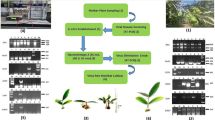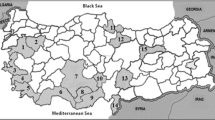Abstract
Bean common mosaic virus (BCMV) is a major seed transmitted virus of common bean (Phaseolus vulgaris). The use of virus-free germplasm is a prerequisite for production of certified seeds, which is an important disease control measure. In this study, the efficiency of electrotherapy in eliminating BCMV and producing virus-free plants in two common bean cultivars, Khomein and Capsouli, was evaluated. Nodal cuttings of infected bean plants were exposed to electric currents of 5, 10 and 15 mA for 10 minutes and planted in vitro. One month old regenerated plantlets were tested by a Double Antibody Sandwich (DAS)-ELISA method for BCMV infection. The three intensities of electric current resulted in mean virus elimination percentages of 37.2%, 45.5% and 71.9% and mean plant regeneration of 79.5%, 68.6% and 58.4%, respectively. The Therapy Efficiency Index for the three electrotherapy treatments was estimated as 28.9, 29.2 and 39.1 in cv Khomein and 26.9, 33.3 and 44.8 in cv Capsouli, respectively. Based on the Therapy Efficiency Indices, an electric current of 15 mA for 10 min was the most effective treatment in both cultivars. The technique developed in this study can be a useful procedure for the production of virus-free germplasm and/or nucleus seed stock in crop plants infected with seed-borne viruses.
Zusammenfassung
Das ewöhnliche Bohnenmosaik-Virus (BCMV) ist eine bedeutende samenbürtige Viruskrankheit bei Phaseolus vulgaris. Die Benutzung von virusfreiem Pflanzmaterial ist Voraussetzung für die Produktion von zertifiziertem Saatgut und ist damit eine wichtige Kontrollmöglichkeit gegenüber dieser Krankheit. In dieser Arbeit wird die Effizienz der Elektrotherapie zur Bekämpfung der BCMV geprüft und virusfreie Phaseolus vulgaris-Pflanzen der Sorten Khomein und Capsouli erzeugt. Stängelabschnitte von infizierten Bohnenpflanzen wurden für 10 min mit Stromstärken von 5, 10, oder 15 mA behandelt und anschliend in in vitro-Kultur übertragen. Die regenerierten, einen Monat alten Jungpflanzen wurden mit einem Doppelantikörpersandwich-(DAS)-ELISA-Test hinsichtlich der BCMV-Infektion getestet. Bei den drei untersuchten Stromstärken konnte eine Unterdrückung der Viren von 37.2%, 45.5% und 71.9% erzielt werden, die durchschnittliche Pflanzenregeneration betrug 79.5%, 68.6% und 58.4%. Mit der Behandlung wurden Effizienzindices von 28.9, 29.2 und 39.1 bei der Sorte Khomein ermittelt sowie 26.9, 33.3 und 44.8 bei der Sorte Capsouli. Hinsichtlich der erzielten Effizienzindices ist die 10 minütige Behandlung mit einer Stromstärke von 15 mA die effektivste Anwendung für beide untersuchten Sorten. Für Nutzpflanzen, die mit samenbürtigen Viren belastet sind, kann die hier entwickelte Technik eine wertvolle Maßnahme für die Herstellung von virusfreiem Pflanzenmaterial sein.
Similar content being viewed by others
References
Angelini, R.R., Allavena, A., 1989: Plant regeneration from immature cotyledon explant cultures of bean (P. coccineus L.). Plant Cell Tissue and Organ Culture. 19, 167–174.
Benedičič, D., M. Ravnikar, N. Gogala, 1997: The regeneration of bean plants from meristem culture. Phyton Horn, 37, 151–160.
Black, J.D., 1971: Electrical stimulation and its effect on growth and ion accumulation in tomato plants. Canadian Journal of Botany, 49, 1805–1815.
Blanchard, R.O., 1974: Electrotherapy: a new approach to wound healing. Proceedings of American Phytopathological Society, 1, 133–134.
Clark, M.R., A.N. Adams, 1977: Characteristics of the micro-plate method of enzyme-linked immunosorbent assay for the detection of plant viruses. Journal of General Virology, 34, 475–483.
Dhital, S.P., H.T. Lim, B.P. Sharma, 2008: Electrotherapy and chemotherapy for eliminating double-infected Potato virus (PLRV, PVY) from in vitro plantlets of potato (Solanum tuberosum). Horticulture Environment and Biotechnology, 49, 52–57.
Drijfhout, E., 1978: Genetic interaction between Phaseolus vulgaris and Bean common mosaic virus with implications for strain identification and breeding for resistance. PhD thesis, University of Wageningen.
Fallah, M., M. Mozafari, N. Sokhandan-Bashir, M. Hashemi, 2007: Elimination of a DNA virus associated with yellow leaf curl disease in tomato using an electrotherapy technique, Second international symposium on tomato diseases, Kusa-dasy, Turkey, 8-12 October 2007.
Galvez, G.E., F.J. Morales, 1989: Aphid-transmitted viruses. In: H.F. Schwartz, M.A. Pastor-Corrales (eds.): Bean production problems in the Tropics, pp. 333–361. CIAT, Colombia.
Goldsworthy, A., 1987: Electrical stimulation of tissue culture growth and morphogenesis. Agriculture cell Report, 8, 14.
González, J.E., R. Sanchez, A. Sanchez, 2006: Biophysical analysis of electric current mediated nucleoprotein inactivation process. First International Workshop on Bioinformatics, Santa Clara, Cuba, 7–10 February, 2006.
Guta, I.C., E.C. Buciumeanu, R.N. Gheorghe, A. Teodorescu, 2010: Solutions to eliminate grapevine leafroll associated virus serotype 1+3 from V. vinifera L. cv. Ranai Magaraci, Romanian Biotechnological Letters, 15, 72–78.
Hammatt, N., T.K. Ghose, M. Davey, 1986: Regeneration in legumes. In: R.H. Zimmermann, R.J. Griesbach, F.A. Hammerschlag, R.H. Lawson (Eds.): Tissue Culture as a Plant Production System for Horticultural Crops. Martinus Nijhoff, Dordrecht.
Hernández, P.R., J. Fontanella, J.C. Noa, T. Pichardo, Y. Igarza, H. Cardenas, R. Manso, 1997: Electrotherapy; a novel method for eliminating viruses from garlic.Hortic Argent, 16, 68–71.
Hernández, P.R., H. Bertrand, P. Lepoiver, J.E. González, X. Rojas, A. Pairol, Y. González, G.Y. González, C. Cortés, 2002: Diagnostico y saneamiento de Banana Streak virus (BSV) en Musa spp. Centro Agrícola, 2, 42–47.
Hormozi-Nejad, M.H., J. Mozafari, F. Rakhshanderoo, 2008: Production and certification of virus-free nucleus seeds in common bean. First national congress on seed science and technology, 12–13 November 2008, Gorgan, Iran.
Mavric, I., J. Šuštar-Vozlic, 2004: Virus diseases and resistance to Bean common mosaic and Bean common mosaic necrosis potyvirus in common bean (Phaseolus vulgaris L.). Acta ag-riculturae slovenica 83, 181–190.
Igarza-Castro, J., P.R. Hernández, B. Cruz Castellanos, 2001: Electrotherapy as an alternative for elimination of the Dasheen Mosaic Virus in Tania. Spanish Manejo Integrado de plagas, 60, 57–60.
Jacobsen, H.J., 1992: Biotechnology applied to grain legumes — current state and prospects. First European Conference on grain legumes, 1–3 June 1992, Angers, France.
Jung-Yoon, Y., S. Hyo-Won, C. Young-Mee, P. Young-Eun, 2003: Ribavirin, electric current and shoot tip culture to eliminate several potato viruses. Journal of Plant Biotechnology, 5, 101–105.
Lozoya-Saldaña, H., F.J. Abelló, G. García, 1996: Electrotherapy and shoot tip culture eliminate potato virus X in potatoes. American Potato Journal, 73, 149–154.
Mahmoud, S.Y.M., M.H. Hosseny, M.H. Abdel-Ghaffar, 2009: Evaluation of some therapies to eliminate potato Y potyvirus from potato plants. International Journal of Virology, 5, 64–76.
Morales, F.J., L. Bos, 1988: Bean common mosaic virus. No. 337. In: Descriptions of Plant Viruses. Association of Applied Biologists, Wellesbourne, England.
Murashige, T., E. Skoog, 1962: A revised medium for rapid growth and bioassays with tobacco tissue culture. Physio-logia Plantarum, 15, 473–497.
Pazhouhande, M., J. Mozafari, 2001: In vitro developement of potato virus-free germplasm. Dissertaion, Tarbiat modarres university.
Quacquerelli, A., O. Gallitelli, V. Savinow, P. Pizzola, 1980: The use of electrical current (RACE) for obtaining mosaic free almonds. Acta Phytopathologíca Academic Scientiarum Hun-garicae 15, 251–255.
Svetleva, D., M. Velcheva, G. Bhowmik, 2003: Biotechnology as a useful tool in common bean (Phaseolus vulgaris L.) improvement. Euphytica, 131, 189–200.
Author information
Authors and Affiliations
Corresponding author
Rights and permissions
About this article
Cite this article
Hormozi-Nejad, M.H., Mozafari, J. & Rakhshandehroo, F. Elimination of Bean common mosaic virus using an electrotherapy technique. J Plant Dis Prot 117, 201–205 (2010). https://doi.org/10.1007/BF03356361
Received:
Accepted:
Published:
Issue Date:
DOI: https://doi.org/10.1007/BF03356361




